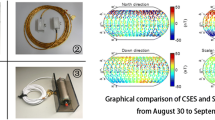Abstract
This study proposes a novel AC vector magnetometer developed using a low-resource magneto-impedance sensor for China’s Feng-Yun meteorological satellite (FY-3E). It was calibrated and characterized to determine its performance parameters. The total weight of the AC vector magnetometer is 51 g (the aluminum box excluded), while the total power consumption is 310 mW. The proposed AC vector magnetometer can detect magnetic field variations in the range of ±1000 nT and noise power spectral density of ⩽ 50 pT/Hz1/2 @ 1 Hz. Furthermore, the proposed device has a maximum nonlinearity of ⩽ 0.71‰ over the entire range and a nonorthogonality error of 3.07 nT or 0.15% (root mean square). The total dose hardness of the sensor is ⩾ 30 krad (Si). Furthermore, we propose the first survey results of a magnetometer equipped aboard a Chinese FY-3E satellite in a Sun-synchronous orbit. The data revealed that the AC vector magnetometer can detect transient physical signals such as quasistatic field-aligned currents (~50 nT) and waves at the auroral latitudes. These features render the proposed AC vector magnetometer suitable for space-based applications, particularly those involving the study of geomagnetic activity.
Similar content being viewed by others
References
Jacobs J A, Kato Y, Matsushita S, et al. Classification of geomagnetic micropulsations. J Geophys Res, 1964, 69: 180–181
Regoli L H, Moldwin M B, Pellioni M, et al. Investigation of a low-cost magneto-inductive magnetometer for space science applications. Geosci Instrum Method Data Syst, 2018, 7: 129–142
Moldwin M. An Introduction to Space Weather. Cambridge: Cambridge University Press, 2008
Rae I J, Watt C E J. ULF waves above the nightside auroral oval during substorm onset. In: Low-Frequency Waves in Space Plasmas. Geophysical Monograph Series, vol. 216. American Geophysical Union, 2016. 99–120
Bleier T, Dunson C. ELF magnetic field monitoring of the San Simeon M6.4 quake from both QuakeSat and a ground network. In: Proceedings of the International Workshop on Seismo-Electromagnetics. Tokyo, 2005. 15–17
Summers D, Thorne R M. Relativistic electron pitch-angle scattering by electromagnetic ion cyclotron waves during geomagnetic storms. J Geophys Res, 2003, 108: 1143
Meredith N P, Horne R B, Kersten T, et al. Global morphology and spectral properties of EMIC waves derived from CRRES observations. J Geophys Res Space Phys, 2014, 119: 5328–5342
Summers D, Ni B, Meredith N P. Timescales for radiation belt electron acceleration and loss due to resonant wave-particle interactions: 2. Evaluation for VLF chorus, ELF hiss, and electromagnetic ion cyclotron waves. J Geophys Res, 2007, 112: A04207
Summers D. Quasi-linear diffusion coefficients for field-aligned electromagnetic waves with applications to the magnetosphere. J Geophys Res, 2005, 110: A08213
Díaz-Michelena M. Small magnetic sensors for space applications. Sensors, 2009, 9: 2271–2288
Archer M O, Horbury T S, Brown P, et al. The MAGIC of CINEMA: First in-flight science results from a miniaturised anisotropic magnetoresistive magnetometer. Ann Geophys, 2015, 33: 725–735
Brown P, Whiteside B J, Beek T J, et al. Space magnetometer based on an anisotropic magnetoresistive hybrid sensor. Rev Sci Instrum, 2014, 85: 125117
Mohri K, Uchiyama T, Shen L P, et al. Amorphous wire and CMOS IC-based sensitive micro-magnetic sensors (MI sensor and SI sensor) for intelligent measurements and controls. J Magn Magn Mater, 2002, 249: 351–356
Beato-López J J, de la Cruz Blas C A, Mitra A, et al. Electrical model of giant magnetoimpedance sensors based on continued fractions. Sens Actuat A-Phys, 2016, 242: 73–78
Hamada N, Shimode A, Tatematsu S, et al. Test-production of high sensitivity multi-core MI element and its characteristics. In: Progress in Electromagnetic Research Symposium (PIERS). Guangzhou, 2014. 863–866
Honkura Y. Development of amorphous wire type MI sensors for automobile use. J Magn Magn Mater, 2002, 249: 375–381
Nakayama S, Uchiyama T. Real-time measurement of biomagnetic vector fields in functional syncytium using amorphous metal. Sci Rep, 2015, 5: 8837
Kanno T, Mohri K, Yagi T, et al. Amorphous wire MI micro sensor using C-MOS IC multivibrator. IEEE Trans Magn, 1997, 33: 3358–3360
Mohri K, Uchiyama T, Shen L P, et al. Sensitive micro magnetic sensor family utilizing magneto-impedance (MI) and stress-impedance (SI) effects for intelligent measurements and controls. Sens Actuat A-Phys, 2001, 91: 85–90
Liu Y X, Li X S, Zhang X J, et al. Novel calibration algorithm for a three-axis strapdown magnetometer. Sensors, 2014, 14: 8485–8504
Schulz L, Heinisch P, Richter I. Calibration of off-the-shelf anisotropic magnetoresistance magnetometers. Sensors, 2019, 19: 1850–1867
Springmann J C, Cutler J W. Attitude-independent magnetometer calibration with time-varying bias. J Guidance Control Dyn, 2012, 35: 1080–1088
Yu X Q, Xiao C J, Liu S, et al. Calibration of AC vector magnetometer based on ellipsoid fitting. IEEE Trans Instrum Meas, 2021, 70: 1–6
Yu X Q, Wang Y F, Xiao C J, et al. Practicable method to identify ferromagnetic objects. Sci China Tech Sci, 2022, 65: 3079–3081
Author information
Authors and Affiliations
Corresponding authors
Additional information
This work was supported by the National Natural Science Foundation of China (Grant No. 42074223). The authors would also like to thank National Center for Space Weather for providing the in-flight data.
Rights and permissions
About this article
Cite this article
Yu, X., Huang, C., Xiao, C. et al. AC vector magnetometer for space-based applications using low-resource magneto-impedance sensor. Sci. China Technol. Sci. 66, 3663–3670 (2023). https://doi.org/10.1007/s11431-022-2390-2
Received:
Accepted:
Published:
Issue Date:
DOI: https://doi.org/10.1007/s11431-022-2390-2




